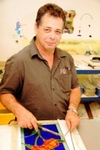FULL COLOR UV DIGITAL PRINTING (INCLUDING WHITE INK) ON HARD SURFACES: Glass, ceramics, porcelain, stone, Perspex, Formica, metal, wood, leather, PVC, marble, rice paper. Possibility of coatings in various grades of protection, from epoxy lacquer to complex epoxy materials which stand up to massive abrasion. Requires that you provide a high-quality digital file, or we can use one from our collection of images. Printing is usually done directly on the base material. It is possible to print on a transparency sandwiched in clear glass (layered glass - triplex) thus permitting viewing through the glass as is seen in Jerusalem by night. Direct printing on glass in layered glass protects the printing (recommended in most cases). Opaque printing on a white background, not transparent, is suitable for places where there is a wall and backlighting. Printing on completely clear lead-free glass improves the final result, without the greenish tint of the glass (this is expensive glass). Printing an overlay affixed to the glass, cheaper but not as durable, makes it possible to print on existing glass when it is not possible or not worthwhile to replace the glass. Printing on ceramic materials requires a coating, depending on the location: moist places demand glazing, floor ceramics will be protected with extremely durable (protected against both wear in use and cleaning materials) epoxy. Printing on Perspex is recommended only when use of glass is not possible. Print width up to 280 cm, on materials of up to 10 cm thickness Doors (less than 10 cm thick) can be printed - perfect for kitchen doors or cabinets. Another example - different prints on ceramic tiles which are then assembled into a complete picture on the entire surface. The printer is suitable for flat, stiff materials (surfaces which are not flat cannot be printed). The machine?s characteristics open up unlimited possibilities in many areas: architecture, interior design, industrial design. The cutting-edge technology is pioneering and unique, for many reasons: speed, price and applications (when compared to silkscreen or ceramic printing). Lampshades - printing on Perspex, fabric or rice paper can lead to original and special designs, both for production lines and for individual shades which create the desired atmosphere.





